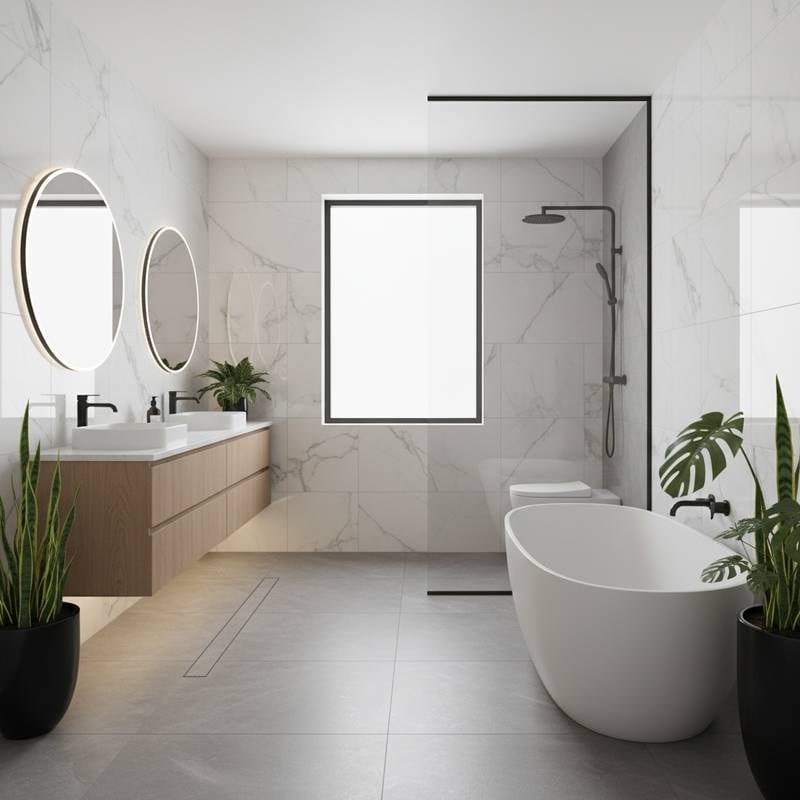Wet Room vs. Traditional Bathroom: A Detailed Cost Comparison
A bathroom remodel enhances daily comfort and boosts property value, yet budget constraints often dictate the design choice. Between a wet room and a traditional setup, costs vary based on construction demands, materials, and installation complexity. This guide examines the essentials of each approach, highlights key expense drivers, and provides strategies to optimize your investment for long-term satisfaction.
Defining the Layouts
A wet room features an open, fully enclosed space where the shower integrates seamlessly without barriers. Water flows across a gently sloped floor to a central drain, with all surfaces treated for waterproofing. This design promotes a spacious, contemporary aesthetic ideal for accessibility, particularly in homes with mobility needs.
In contrast, a traditional bathroom isolates the wet area using a shower tray, tub surround, or enclosure. Dry zones remain unaffected, allowing standard flooring and simpler sealing. This configuration suits families or those preferring defined spaces, offering flexibility in decor and easier retrofits.
Each layout serves distinct purposes, influencing not only aesthetics but also the financial and practical aspects of renovation.
Overall Cost Breakdown
Remodel expenses depend on square footage, location, and material quality, but patterns hold across projects. A typical wet room conversion ranges from $15,000 to $30,000 for a 50-square-foot space, driven by comprehensive waterproofing and custom drainage. Traditional remodels fall between $8,000 and $20,000, benefiting from localized updates and reuse of existing infrastructure.
Wet rooms incur 25 to 50 percent higher costs due to labor-intensive elements like tanking membranes and anti-slip flooring. Traditional options save through modular fixtures and minimal structural changes. Over time, a wet room might recoup expenses via improved resale appeal in modern markets, while traditional designs maintain broad compatibility.
Factors Influencing Expenses
Beyond initial quotes, several elements determine the total outlay. Addressing these early prevents surprises and ensures a durable result.
Structural Preparations
Wet rooms necessitate a sloped subfloor, often requiring underlayment reinforcement in older structures to support the incline and prevent sagging. Expect $2,000 to $5,000 for these adjustments if beams or joists need strengthening. Traditional bathrooms rarely demand such work, limiting prep costs to $500 to $1,500 for basic leveling or damage repairs.
Plumbing and Drainage Systems
Repositioning pipes adds $1,500 to $4,000 in both scenarios, but wet rooms amplify this with linear drains and precise gradient plumbing. Traditional setups leverage current lines, reducing modifications unless expanding the layout. Consult a plumber during planning to map efficient routes.
Materials and Finishes
Select moisture-resistant options to safeguard against wear. Wet rooms call for large-format porcelain tiles ($10 to $20 per square foot) and silicone sealants, totaling $3,000 to $6,000 for surfaces. Traditional designs permit vinyl or laminate in dry areas ($5 to $15 per square foot), keeping material budgets at $2,000 to $4,000. Prioritize sealed grout and epoxy paints for longevity in either case.
Labor and Expertise
Skilled tradespeople charge $50 to $100 per hour, with wet rooms requiring 20 to 40 percent more time for waterproof testing and tiling precision. Budget $5,000 to $10,000 for labor in a wet room versus $3,000 to $7,000 for traditional. Verify contractor certifications in waterproof systems to avoid costly callbacks.
Pros and Cons at a Glance
-
Wet Room Advantages: Seamless design maximizes space; superior accessibility with no thresholds; easy cleaning in open layouts.
-
Wet Room Drawbacks: Higher upfront investment; potential for water splatter without proper sealing; complex repairs if leaks occur.
-
Traditional Advantages: Lower costs and quicker installation; versatile styling options; contained moisture reduces slip risks.
-
Traditional Drawbacks: Less open feel in smaller spaces; barriers may hinder mobility; periodic enclosure maintenance needed.
Steps to Plan Your Remodel
Start by assessing your space and needs. Measure the bathroom, note existing plumbing, and envision usage patterns, such as family bathing versus guest access.
- Gather inspiration from design resources and compile a prioritized list of features, like rainfall showers or storage solutions.
- Obtain multiple bids from vetted contractors, specifying wet room or traditional elements for accurate estimates.
- Factor in permits and timelines, which add 10 to 15 percent to costs but ensure compliance.
- Explore financing options or phased updates to manage expenses without compromising quality.
Selecting the Right Approach for Your Home
Align your decision with practical realities. A wet room suits minimalist, barrier-free living and delivers a premium spa-like experience, justifying the premium if accessibility matters. Traditional designs provide reliable functionality at a fraction of the price, ideal for classic homes or tight budgets.
Ultimately, focus on how the remodel integrates with your routine and architecture. Detailed planning yields a space that enhances comfort, withstands daily use, and preserves value for the future.











